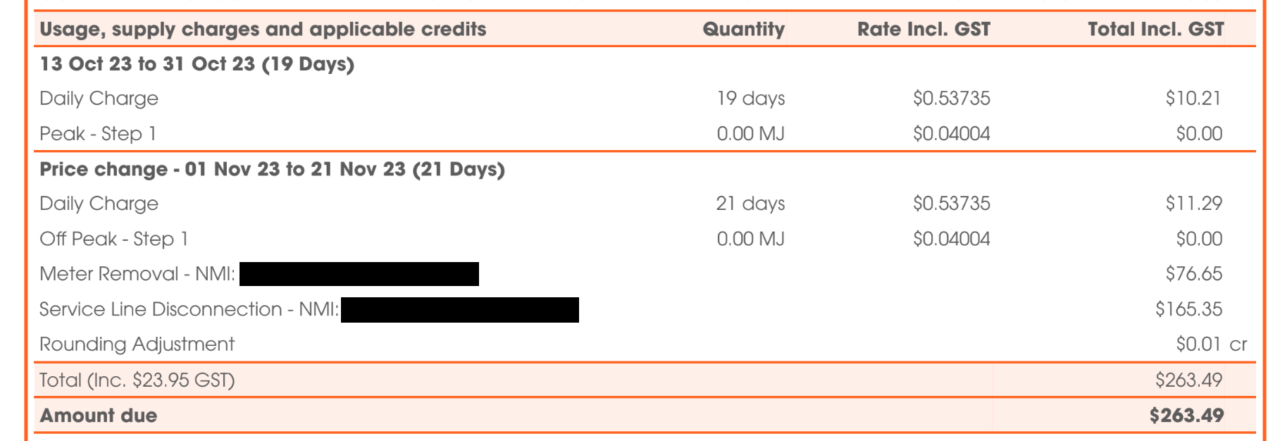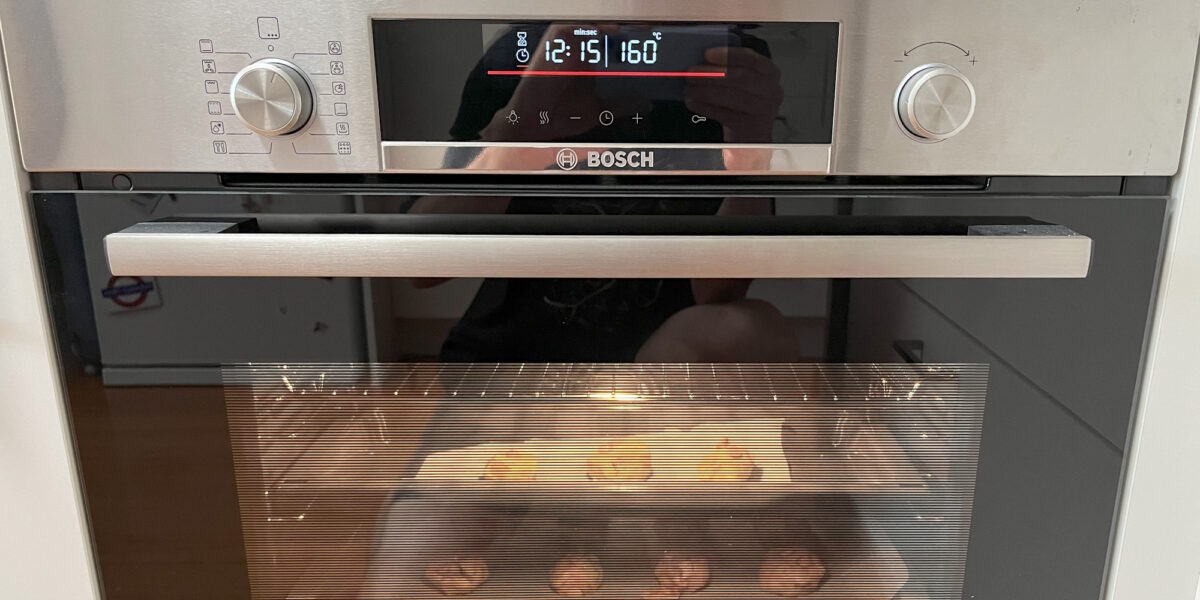My recent kitchen renovation included an electric oven and induction stove top. I’d previously switched the heating from gas central heating to split systems (four of them distributed around the house), and changed over the gas boost solar hot water for an electric heat pump.
Along with the solar panels on the roof, my house is now entirely electric. Well, except for the petrol car and gas bottle barbecue. (And let’s be honest, in most households a petrol or diesel car is the biggest source of emissions.)
During the kitchen renovation, I had the gas connection removed. For anybody wondering, here’s the process.
Prior to disconnection, the daily supply charge was 53.7 cents, or $32.24 every 60 days. By the end, I was barely using any actual gas – virtually all my cooking used a small portable induction unit, a slow cooker or an air fryer. Just occasionally I’d use the stove/oven.
(I’d switched my gas retailer to Alinta a year or two ago – of all the gas retailers, they were cheapest for someone who uses very little gas; they had the lowest daily supply charge.)
While the kitchen was being deconstructed, I emailed Alinta asking to be disconnected. Turns out in gas company jargon it’s called “abolishment”, which sounds far more dramatic – and means the connection is actually removed, not just temporarily unused because someone is moving out.
It took a week or two, but they got back to me to advise of costs imposed by the distributor for abolishment: $76.65 for removal of the gas meter, plus $165.35 for disconnection of the gas line, a total of $242, plus of course any outstanding charges.
Once I acknowledged the costs, they also needed to know where the gas meter was located.
Then they booked me in. At first they weren’t sure they had a team available before Christmas, but then they found an earlier date. Was that okay? Absolutely!

On the day, they turned up, checked where everything was, then dug up the nature strip across the road and disconnected the line, and took the meter away.
There’s still a short length of pipe from the house to where the gas meter used to be, but that’s my problem. At some stage I’ll get that removed. There’s also still a gas central heating unit in the roof.
About a week later, Alinta sent my final bill with the fees as previously flagged, plus the daily connection charge up to the date they removed everything.
I’ve heard that in some parts of Australia, disconnection (oh I’m sorry, abolishment) is a bit complicated. But in this case it was all very straightforward.
Apart from cutting emissions and saving money, given the long term health risks, I’m very glad to have been able to do it.
And by the way, the new oven and stove top are great!
UPDATES: Minor rewording regarding gas retailer vs distributor.

17 replies on “Disconnecting the gas”
I’m wondering if anything had to be done to your electric supply to cater for the induction cooktop?
When my mother had her gas disconnected well over a decade ago, the meter and piping were left in place and as far as I know, they are still there. I don’t think there was a charge.
It helps that the Australian Energy Regulator (AER) ruled in June 2023 that abolishment in Victoria would be capped at $220. This came after a complaint was lodged about the costs varying into the thousands…
Linked from https://www.energy.vic.gov.au/households/save-with-all-electric-home is a “Disconnecting from fossil gas” doc that has a summary of options and costs.
While you went with “Service abolishment” I need to get around to requesting just “Meter removal” as I am in a unit and the other unit still uses gas.
“Apart from cutting emissions”
That’s the case only if the electricity used is based on hydro/wind/solar and not brown coal (where two-thirds of Victoria’s electricity is derived). Replacing gas with brown coal generated electricity increases emissions a lot.
@Andrew Cee, as part of the kitchen reno, the electricians checked everything to see if it would handle induction. They said the switchboard needed to be replaced, but other than that it was all good.
@Stephen, very interesting – thanks.
@roger, green power all the way!
My gas meter abolishment was similarly painless. We got a heat pump for hot water just before Christmas. Missed the cutoff for the team to remove the meter, but a few clangs and bangs outside the front door and the meter was gone in the first week in January.
Final bill from Red energy It cost even less that yours to get it done. I was expecting to pay the whole $220
On the topic of health, most medicinal herbs cannot be cooked in iron pots. They require either a glass or clay pot which are incompatible with induction ovens. You are less likely to resort to herbal medicine but in case you have to at some stage, this is something to keep in mind.
It does sound like the ‘death spiral’ for residential gas supply in Victoria has begun – as households go all-electric, the rather high fixed cost of the gas network has to be apportioned amongst fewer households, and the incentive to disconnect the gas becomes stronger. In the absence of governments making a decision about things like this, the market tends to do it for them.
Though I see the Victorian government has actually made a policy decision in favour of all-electric, over decarbonising gas – new houses from 2024 are all electric, a piece of news I’d missed. The UK’s approach to this issue has been quite confused with lots of investment into both pathways, resulting in it spending more than it needs to and arguably doing neither of them well or efficiently.
To all those smarter than me, advice please. I had a newhouse built recently with non – negotiable gas connection. So I have a 900mm gas burner stove, and under it, all the power I will need to power an induction stove top.
How do I get an induction stove top to “fit” a near new stone benchtop? Or should I budget for a new benchtop as well ?
@Vaughan, yes I think there will be a momentum now that new houses won’t have gas. I don’t know if too many people are converting existing houses, mind you.
@Alpal, it sounds like (if possible) you should get the specs of the benchtop and see if you can match it up to a stovetop, and/or talk to a kitchen benchtop expert.
On 22 Jan I called up my retailer to request my connection be abolished, no specific time was arranged.
A team of two arrived just before lunch today. They were only here for an hour, but in that time they located where the services were for both units, dug up (and filled back in) the nature strip to disconnect my service, removed the meter and cut off the upstand at ground level.
Now I will wait for my final bill with the $220 (ex-GST) charge, but more importantly no more $1.06 daily charge…
Roger – you are largely incorrect in your statement that “using electricity if derived from brown coal is higher emissions than fossil gas”. The main point of importance is the notion of ‘end use energy’. The primary differentiator here is driven by the efficiency of the appliance. In particular heat pump vs gas for space and / or water heating.
Here is some maths:
– 1 unit of heat from gas requires ~ 1.25 unit of the fuel (for an efficient boiler). For fossil gas, emissions are 0.054t CO2 e per kg CH4 (methane) from direct combustion (ignoring upstream fugitive emissions for the time being). As such, 1 GJ of derived / useful heat (to either space or water) will result in ~68kg combustion related GHG emissions. Plus the leakage of methane upstream, wth its 25-80x GHG potential…again we ignore this for simplicity.
– for electricity in Victoria, the latest National Greenhouse Emissions factors (NGAF) are 0.79t CO2 / MWh e. The efficiency (depicted a CoP) of heat pump is about 400% typically. As such, to achieve 1GJ of useful heat to a medium (water or space), you require 0.25 GJ of electricity (which is 0.07MWh). The emissions related to this is 56kg. So even in the currently horrifically emissions intensive brown coal dominated grid of Victoria in 2024, heat pump (for space or water heating) is ~20% less emissions intensive.
Oh – and the grid emissions intensity is only going in one direction (down) as renewables continue to be built out. You CANNOT reasonably achieve any material decarbonisation benefits in the fossil gas network (as much as the BS green gas ads will wish you believe).
I trust that satisfactorily answers any FUD you may have experienced.
[…] I stopped using gas two months ago I had been procrastinating about making the call, it was Daniel Bowen’s post about his experience that prompted me to get around to […]
There is an easy cheap way to get off gas. Finish up with your retailer and then wait. You get a letter after a month addressed to “the occupier”. This is to see if you need to connect as though you have moved in. Wait again for another few weeks and you get another. “Intention to disconnect “ and a date to reply by. Wait again and they will do the job for free.
I did the same, my gas meter was left in place. I read an article where someone wanted the meter removed and the gas company wanted over $1000 to dig up the pipes etc. In my case I left the meter there and when I had the stopetop replaced and the wall furnace removed the gas fitter sealed off the pipes, in any case I had turned off the gas supply at the meter. In AGL jargon I wanted a final reading which they did on a day they nominated – all painless. I no longer get a gas bill.
@David and @Daryl, I hope it works for you both! I’m not sure I trust them to not change the rules in future, so I wanted the connection gone, not just disconnected.
I’m just about to install an induction cooktop to replace my last gas appliance on Canberra. The installer will MAKE SAFE the gas.
Then, ActewAGL will charge me $976.65 for the abolishment of my gas meter. This includes purging the line and probably wrecking the common driveway, like they did for my neighbour.
$220 is a steal.
ActewAGL says,
If you’re in the ACT, Queanbeyan, Bungendore or Shoalhaven, we’ll coordinate with the gas network to turn off the gas at the street, purge the gas line and remove the gas meter/s. This will cost $976.65 (incl GST) for a residential meter or $1793.54 (incl GST) for a business meter.
https://www.actewagl.com.au/metering/remove-my-meter#:~:text=If%20you%27re%20in%20the,GST)%20for%20a%20business%20meter